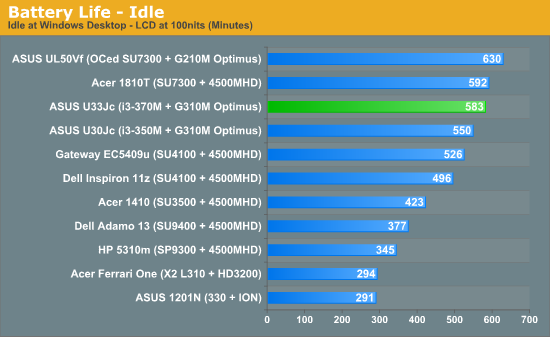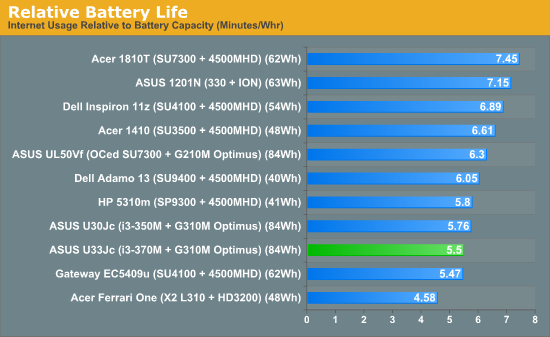Asus U33Jc: Much Ado About Bamboo
by Vivek Gowri on July 29, 2010 9:01 AM ESTASUS U33Jc - Battery Life
With the U30Jc, we found that the combination of a huge 84Wh battery and NVIDIA Optimus resulted in massive battery lifetime. With the same 84 Wh battery and a lower clocked graphics card, the U33Jc delivers battery life that's even more awesome. At idle, you can pull nearly 10 hours of battery life out of it. That’s with a dedicated graphics card and a full voltage processor. Granted, at idle, the graphics card turns off and gives way to the onboard Intel HD Graphics IGP, but it’s nice to be able to have the dedicated graphics and the battery life.




For a more realistic mobile usage scenario, we turn to our internet benchmark, which provides a decent estimate as to what kind of battery life you can expect when actually using the system. The U33 hit more than 7.5 hours of runtime in the internet test, which lines up with the kind of battery life we observed in unscientific field testing. If you’re just running a web browser and basic office productivity tools, you can expect around 8 hours of use before you need to plug it in.
The Core i3, while capable of giving decent battery life, is still far more power hungry than both generations of the CULV platform, so in our CPU-intensive HD video playback test, the U33 naturally suffers in comparison to other thin and lights running CULV. However, due to the huge battery, it’s still competitive and pulls over four hours - good for almost two high-bitrate 720p HD movies encoded in the x264 video codec. Lower bitrate and lower resolution videos will naturally use less power.
Overall, it’s nice to see ASUS consistently deliver portable systems with very strong battery life. I have been following ASUS notebooks long enough to know that it was not always so, and battery life would usually be the first thing to be sacrificed on the alter of performance, even on a 13” notebook.










34 Comments
View All Comments
chrnochime - Friday, July 30, 2010 - link
If you want to do graphic design/photo editing any desktop paired with a good display does a better job than pretty much any laptop on the market anyway.darckhart - Thursday, July 29, 2010 - link
is it the usual nec providing the usb3 support?geok1ng - Thursday, July 29, 2010 - link
"the only differences other than the bamboo and WiDi are the addition of Bluetooth, the lone USB 3.0 port, and a higher resolution 2.0MP webcam"For $150 these differences are a fair trade IMO. The USB 3.0, no matter how "slow"is a welcome feature for futureproofness. and Stile ans status are priceless.
chris1317 - Friday, July 30, 2010 - link
I am really disapointed about the display too. I love the look, need USB3, need a small(ish) laptop.I am also a photographer. Colour accuracy is important to me. 16x10 would also be nice but I dont think that's going to happen :)
Maybe next year ASUS
AstroGuardian - Friday, July 30, 2010 - link
Yea... or maybe never... It seems like Asus s a follower and not a developer of good technology. At least they have been acting like that...erple2 - Saturday, July 31, 2010 - link
Sadly, more or less everyone is a follower. The low resolution 720p crummy displays seem to be the norm in the computer industry, or at least for the laptops that Anandtech reviews. Maybe that's a problem endemic to ACER and ASUS's though.I don't know. Maybe some people just don't get it. The display is one of the most important things about any laptop. oh well...
goinginstyle - Friday, July 30, 2010 - link
Why would you suggest a unit that has not been reviewed yet as a better option? Looking at the specs on Amazon there is probably at least a $75 component difference and the other $75 is for the Bamboo. That $75 seems like an acceptable amount to have a unit that is certainly unique and looks damn good at least to me. Who knows, the U35 might be a bust. I would probably still go with the U30Jc since I need an optical drive or wait for the 14" version of the Bamboo that has both the optical drive and a core i5.lemonadesoda - Sunday, August 1, 2010 - link
I would like to see a thorough review comparing laptop screens (only). IMO, most laptop users don't worry about an extra 5% performance on the CPU... (except perhaps a few people who use their laptop as a gaming rig). However, 95% of laptop users would jump at longer battery performance AND A BETTER SCREEN; whether higher contrast, matte, higher resolution, faster response time, wider gamut, more accurate colour calibration.I would like to see an industry laptop screen roundup here on anandtech. Perhaps that will have a small impact on the industry. And the review pages will become a reference point for many other websites/forums.
Alexo - Sunday, August 1, 2010 - link
Vivek: why would reviewing the U35Jc be a priority when the results are expected to be within a margin of error from the U30Jc and the U33Jc? Wow about reviewing the UL30Jt instead (or in addition)? Or even better, the PL30Jt that is available with a matte display?Joepublic2 - Tuesday, August 3, 2010 - link
Tensile strength of "steel". Mild steel I'll give them that; most tool steels and structural aluminum alloys like the 2000 or 7000 series no fucking way. I'm more worried about the compressive and fatigue strength of a material when it's being used a structural component for a laptop that I've plunked down roughly a grand for.Seriously, a "green" laptop is one of the dumber ideas I've ever heard of. More than a ton of petroleum is used in this laptop's production and assembly regardless of what its outer shell is made of.
Computers will never be "green"; they require tons of energy and ghastly chemicals to produce their ICs and tons of oil in the form of energy and structural precursors to fabricate their PCBs and other electrical components.